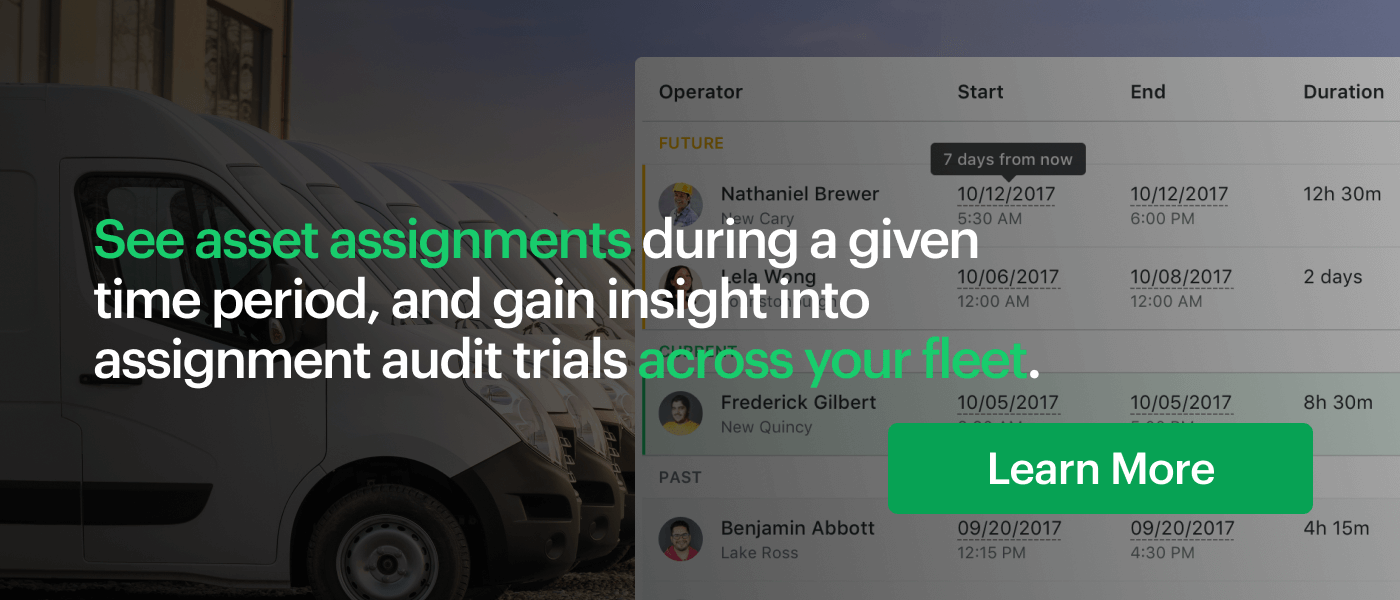Did you know there are many ways to collect driver behavior-related data? Understanding how to collect driver behavior data and from where, as well as its role in fleet reporting, can help you discern drivers with problematic behaviors from top-performing drivers so you can take the proper steps to coach and reward respectively for maximized asset lifespan and talent retention.

Fleet management software (FMS) and solutions work in conjunction to give users powerful insights into the health and operation of their fleet. As more software integrations become available — including finance, human resources and other organization-wide integrations — so does the potential to get bogged down in data. Understanding Fleet Data is a series where we break down the different types of fleet data you can get from FMS and other solutions to give fleet managers a better understanding of:
- What data is collected from what source
- How collected data interacts to provide in-depth insights for proactive actions
- How to apply insights practically to improve fleet operations
In this post, we’ll be talking about driver behavior-related data and how to capitalize on insights gleaned from it.
Leveraging Spreadsheet Data
Paper forms and spreadsheets will always be the cheapest method of documenting fleet data up front, and you can get a large variety of data that way — including driver behavior-related data. Unfortunately, manual data tracking also means having to manually cross reference data points across numerous sources to procure the metric you’re looking for, costing you a lot of wasted time on the back end. By cross referencing such data points as fuel logs, preventative maintenance (PM) schedules and work orders you can better determine:
- Whether increased fuel use is due to asset age/condition or driver behavior (if theft/misuse has been ruled out)
- Whether an increase in actual PM versus scheduled PM is due to asset age/condition or driver behavior
- Whether increased wear and tear or additional non-PM services are due to asset age/condition or driver behavior
Let’s take a closer look at how the above data points work together to produce actionable insights into driver behavior.
Leveraging Fuel and Maintenance Data
We often say that a fleet’s two largest variable expenses are maintenance and fuel, making tracking related data pretty high up on the priority list. But the additional fleet management metrics gathered from maintenance and fuel data can often go unnoticed. So how does this type of data relate to driver behavior?
- Fuel logs: By consistently tracking your fleet assets’ fuel spend and comparing assets’ projected average mpg to their actual mpg, you can start picking up on red flags. Some discrepancies can point to fuel theft/misuse or a natural decline as the asset ages; however, additional causes include increased fuel consumption due to speeding, erratic driving and extended idle times.
- PM schedules and inspections: Inspections and PM schedules go hand-in-hand when it comes to being proactive with maintenance. If you’re adjusting a vehicle’s PM schedule to be more frequent due to recurring inspection fail items or unnatural wear and tear, you might have driver behavior problems.
- Work orders: Work orders are a great source of data to help you key in on service issues if filled out thoroughly. Identify driver behavior-related service issues by eliminating services related to defective parts, common repairs (flat tire, dead battery, etc.) and recalls.
FMS consolidates all your fleet’s data — including fuel and maintenance — to automate reports you can use to quickly track down driver behavior issues.
Leveraging Telematics Data
Telematics is the obvious choice for monitoring driver behavior. With GPS tracking and on-board diagnostic reading capabilities, telematics can internally monitor such behaviors as speeding and harsh acceleration, braking and cornering. Users can opt to receive notifications any time these behaviors trigger an alert and can pull weekly, monthly or annual reports for specific vehicles or drivers.
Many telematics services have also made dash cams available to better monitor what’s going on in the cab and on the road. Dash cams are a great way to get a better picture of unwanted driving behaviors and their cause. Additionally, many telematics services offer driver safety resources for coaching poor behavior and rewarding top-performing drivers to help support driver retention.

Leveraging FMS Data
We’ve touched on how FMS can centralize and consolidate fleet data. The key takeaway from leveraging FMS is the ability to automate reports based on that consolidated data. These reports, which are configurable by filters, make it easy to quickly cross reference information pertinent to the fleet metric you’re tracking.
When integrating your telematics data into FMS, you can get a better idea of how unwanted driver behaviors are impacting your fleet from cost, downtime and lost revenue standpoints to better assess risk management when determining if coaching or training is the best course of action.
- Cost: There are a couple of ways you can determine how much poor driver behavior is costing you in maintenance. The first is to compare a vehicles’ actual service history against its PM schedule, and the second is to compare it to a baseline asset in your fleet. While the former is the easier of the two, having a comparable baseline gives you better, more detailed information. There are two criteria for a baseline asset: it must have been procured at or near the same time as the vehicle in question — both vehicles being in similar condition at the time of procurement — and its driver must meet your standard of asset operation (i.e. your company’s standard for excellence for drivers). The difference between the baseline and the vehicle in question will give you a good idea of how much in maintenance spend poor driver behavior costs for any given assigned asset. It’s important to mention that this is harder — but not impossible — to track if vehicles are assigned to multiple drivers, and pre-trip inspections are another source of data that can help bolster this metric.
- Downtime: If you’re looking to quantify a vehicle’s downtime over a specific period during which the vehicle was assigned to a specific driver whose behavior is in question, a great way to do this at a glance is to view the vehicle’s status summary report in FMS. Status summaries show to the day, hour and minute how long a vehicle has been active, inactive, in the shop or out of service. As with cost, you can compare this summary against the vehicle’s PM schedule (allowing for common wear and tear instances) or to a baseline vehicle’s status summary.
- Lost revenue: To identify lost revenue associated with poor driver behavior, you’ll first need to know at or around the amount specific jobs cost from an asset utilization standpoint versus how much your organization is compensated for those jobs. Next, you’ll calculate the discrepancy in downtime hours between your baseline vehicle (from above) and the vehicle assigned to the driver in question. Finally, compare hours lost from avoidable downtime to potential job hours that the driver in question could have worked had the vehicle been in optimal operating condition, and you’ll have a ballpark for lost revenue due to poor driving behavior.
Having quantifiable data around the impact of driver behavior can help you prioritize ride-alongs and/or coaching for mid- and high-risk drivers. Additionally, you can keep track of your top-performing drivers to reward or incentivize continued safe driving for improved retention.
Have a topic about which you’d like us to break down the data? Let us know in the form below!
Previous Series Posts
Understanding Fleet Data: Fuel
Want to see how Fleetio can help you monitor driver behavior? Start your free trial or request a demo today!




